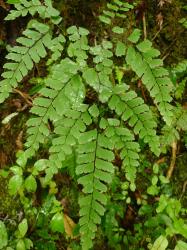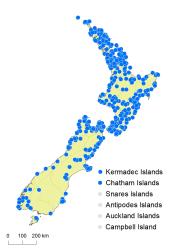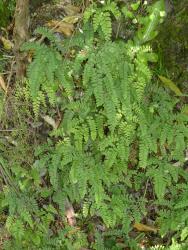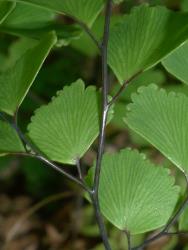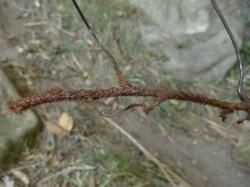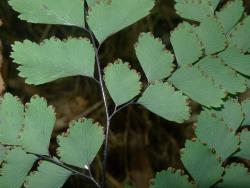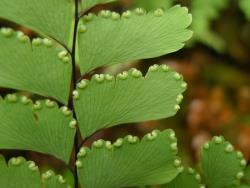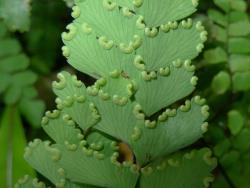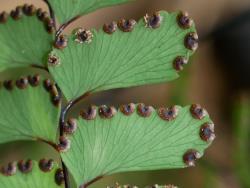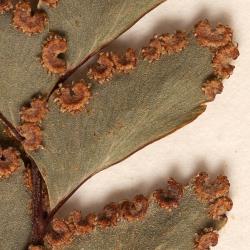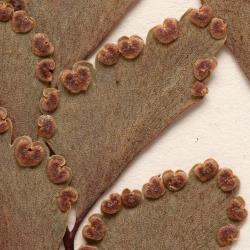- ≡ Adiantum formosum var. cunninghamii (Hook.) F.Muell., Veg. Chatham Isl. 72 (1864)
- = Adiantum trapeziforme G.Forst., Fl. Ins. Austr. 84 (1786) nom. illeg., non Adiantum trapeziforme L. 1753
- = Adiantum affine var. heterophyllum Colenso, Trans. & Proc. New Zealand Inst. 20: 218 (1888)
- = Adiantum affine var. chathamicum Field, Ferns New Zealand 81 (1890)
- = Adiantum pullum Colenso, Trans. & Proc. New Zealand Inst. 25: 319 (1893)
- ≡ Adiantum affine var. pullum (Colenso) Domin, Biblioth. Bot. 20(85): 150 (1913)
Rhizomes short- to long-creeping, up to 235 mm long (in herbarium specimens), 1–3 mm diameter, with stipes inserted 5–50 mm apart; bearing scales; stolons and tubers absent. Rhizome scales narrowly ovate, 2.5–6.0 mm long, 0.3–0.6 mm wide, red-brown, concolorous. Fronds 60–900 mm long. Stipes 20–530 mm long, dark brown, polished, glabrous except for scattered scales proximally. Rachises dark brown, sulcate, polished, glabrous. Laminae 2–3-pinnate (or very rarely 4-pinnate), broadly ovate or ovate, 40–370 mm long, 25–260 mm wide, dark green adaxially, glaucous or green abaxially, herbaceous, glabrous or rarely bearing stiff dark hairs abaxially. 1–4 pairs of divided primary pinnae below long pinnate apex, widely spaced especially proximally, ovate or broadly ovate; costae glabrous; the longest pinnae below the middle, 16–230 mm long, 9–150 mm wide, apices acute to obtuse, bases stalked, divided into secondary pinnae. 1–2 pairs of secondary pinnae (or occasionally none) on the basal primary pinnae divided into tertiary pinnae; the longest divided secondary pinnae ovate or narrowly ovate, 10–105 mm long, 9–28 mm wide, apices acute to obtuse, bases stalked. Very rarely one tertiary pinna on the basal primary pinna divided into quaternary pinnae. Longest ultimate lamina segments oblong, tending to curve acroscopically, 5–28 mm long, 3–15 mm wide, apices obtuse, acroscopic margins irregularly toothed, basiscopic margins ± entire, bases stalked, with stalks attached in one corner. Reflexed lamina flaps reniform, glabrous.
Adiantum cunninghamii is a rather variable species with laminae ranging in size from 40 mm to 370 mm long. It is most commonly 3-pinnate at the base, but small fronds may be only 2-pinnate, and very rarely 4-pinnate fronds are found. It is distinguished from other species of Adiantum by its oblong ultimate lamina segments with the stalk attached in one corner, glabrous rachises, reniform and glabrous “indusia”, and often by the glaucous colour of the abaxial lamina surface. The abaxial lamina surfaces are also usually glabrous, but rarely (in <1% of collections) they bear stiff hairs. Such plants can be confused with hairy forms of A. diaphanum. Small, 2-pinnate fronds, lacking hairs on the abaxial lamina surfaces, can also be confused with glabrous forms of A. diaphanum, but A. cunninghamii always lacks the small tubers on the rootlets that are present in A. diaphanum. Large, 3–4-pinnate specimens can be distinguished from A. formosum by their glabrous costae on the primary pinnae, and by the often glaucous abaxial lamina surface.
North Island: Northland, Auckland, Volcanic Plateau, Gisborne, Taranaki, Southern North Island.
South Island: Western Nelson, Sounds-Nelson, Marlborough, Westland, Canterbury, Otago, Southland, Fiordland.
Kermadec Islands, Three Kings Islands, Chatham Islands, Stewart Island.
Altitudinal range: 0–1100 m.
Adiantum cunninghamii occurs on the Kermadec and Three Kings Islands, and in lowland areas throughout the North Island from Te Paki to Wellington, extending locally into montane sites. It is absent only from parts of the central North Island. It grows from near sea-level, reaching 1100 m in the Kaimanawa Ranges. In the South Island it occurs in coastal and lowland sites from Nelson to Southland, extending locally into montane areas, but is absent from much of the interior, and from the drier parts of Otago and South Canterbury. It extends to 900 m at Jordan Stream Reserve, Marlborough. It also reaches Stewart Island and the Chatham Islands.
Adiantum cunninghamii grows on the ground under kauri, podocarp, beech and broadleaved forest, under mānuka and kānuka, in coastal and regenerating scrub, and under pines. It is found on wet rock faces and bluffs, in small caves, under waterfalls, on river banks, in gullies, among rocks or in crevices, on roadside banks, at bush margins, in clearings, along tracksides, on grassy slopes, and on coastal cliffs. It grows on greywacke, limestone, sandstone, mudstone, clay, scoria, and pumice.
It is possible that Adiantum cunninghamii hybridises occasionally with A. fulvum. One collection (AK 353971) has hairs on the abaxial pinna surfaces and vestigial hairs on the rachises, but the sori are over-mature and the nature of the spores unknown (Brownsey et al. 2019).
n = 58 (Brownlie 1961, as A. affine).
Adiantum cunninghamii was initially misidentified by early Flora writers as A. formosum R.Br. (e.g. Richard 1832), and then as A. affine Willd. (e.g. Cheeseman 1906). The type of the latter name is actually A. capillus-veneris, supposedly from New Zealand, but almost certainly with an incorrect provenance (see under Notes for A. capillus-veneris). Along with A. fulvum, it is closely related to A. silvaticum from Queensland and New South Wales. The latter differs from A. cunninghamii by the absence of false veins between the true veins on the adaxial lamina surface (Bostock 1998).
No type material of Adiantum affine var. chathamicum has been located at AK, CHR, K or WELT, and its identity remains unresolved (Brownsey & Perrie 2020). However, Field (1890) noted that A. affine was called A. cunninghamii by Hooker, and A. affine var. chathamicum is included here as a likely synonym of A. cunninghamii.
A small number of collections occur with hairs on the abaxial lamina surfaces (Brownsey et al. 2019). These are treated here alongside the more usual glabrous forms as dimorphic variation within A. cunninghamii.



